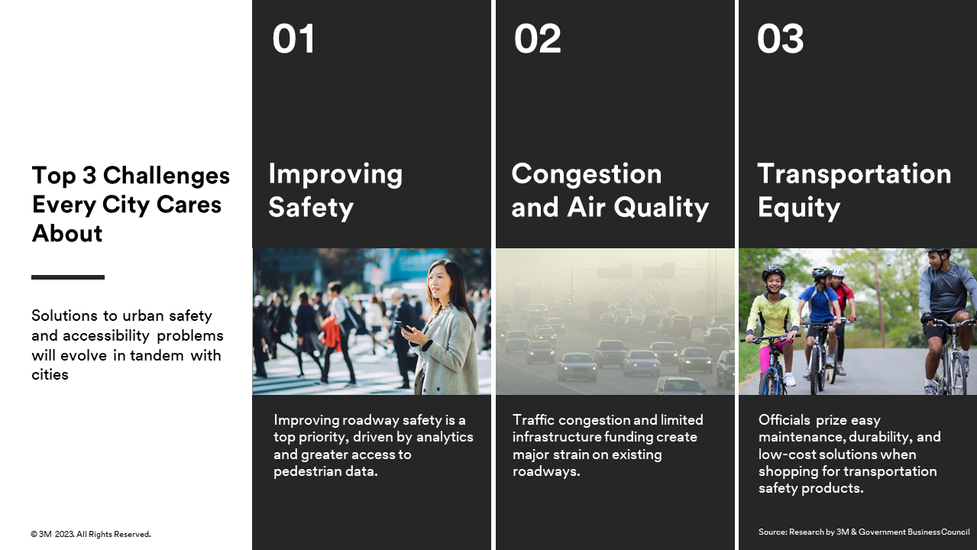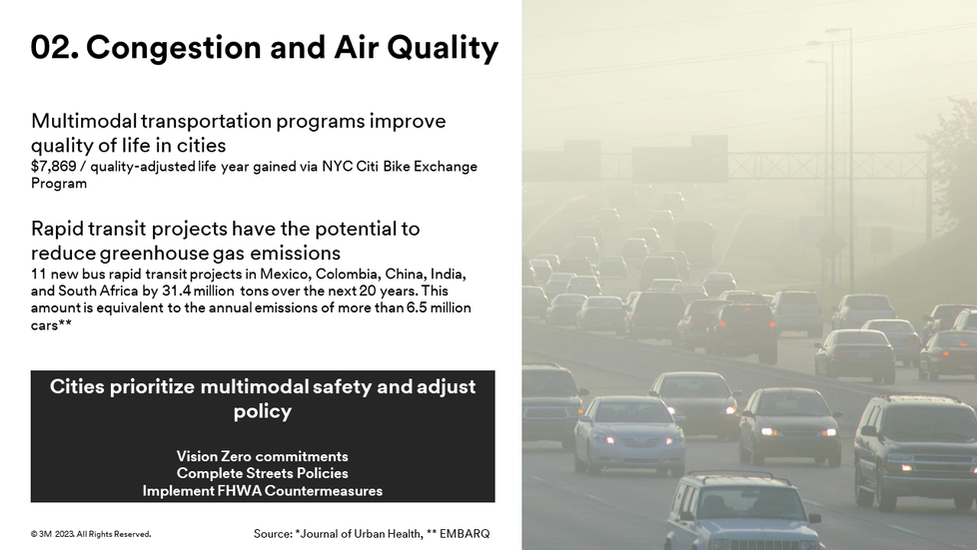
Urban Mobility
City Limits
Virtual Reality
OVERVIEW
3M began a very large Urban Mobility campaign to identify products and solutions that would make urban roads safer for vulnerable road users (pedestrians, bikers, and scooter users). This VR simulation was a large part of that campaign. The primary goal was to give users an empathetic interactive experience that could communicate to all our customers, government officials and road users.
This demonstration was designed in such a way that it would be an effective VR demonstration, 360 video, standard 2D video, and GIF clips from it could be used on social media and the company website.
ROLE & DURATION
Project Design Lead | 3M
Storyboarding, Design Strategy, Creative Direction, User Research, Testing, Product Launch & Management
Jan - May 2020
The Problem
City bikers, pedestrians, and scooter users face many challenges when they interact with cars. 3M has many solutions that can help and it wants to communicate that to city officials who plan these streets, and to citizens who advocate for safer roadways. The key to doing this is through empathetic content that shows how dangerous life is for vulnerable road users. Pictures and video's are not as effective as being on the road while you witness a potential accident. So how do we put our customers in these dangerous situations without endangering them in the process? How can we give them the opportunity to see first hand the solutions that can save lives?
Insights into the evolving designs of Urban Roads
When designing this demonstration and the rest of the Urban Mobility campaign it was extremely important to understand what issues cities are dealing with, what products 3M currently has to solve them, and what design solutions 3M can offer for further improvement. I designed this deck to visualize this data and communicate those findings which helped to inform the rest of the design work.
Scroll through to learn more.
Design Goals
I had three primary design goals going into the project based on the insights I gathered. These were the driving pillars I would go back to every time I made decisions during the course of this project.
1.
Create an experience that will increase the empathy of our customers to the needs of the Urban Mobility community.
2.
Reinforce 3M’s product relevance in this space.
3.
Create motivation to make infrastructure improvements that will lead to safer roadways for micromobility users.
Identifying Customer Needs
Research was integral to this project. I spent hours meeting with Traffic Engineers to better understand what road solutions are effective and how our products could be used to enable them. I spoke with bike advocacy groups to better understand their needs and how they communicate with government officials. I spoke with global resources to make sure that the demonstration did not get too US centric (though that can be unavoidable in some instances). I also spoke with our sales team to know how they would utilize a tool like this.
Most important, I traveled to as many areas as I could to experience, first hand, the dangers facing road users.
I identified two unique customers I needed to communicate with, the City Government and the City Road Users. They have similar, but different needs and concerns regarding road safety in urban environments. So I mapped out these customers persona's to better understand how to communicate with them.





Using Empathy to Connect with Customers
Customers needed to "feel" what it was like to be in a dangerous situation as a pedestrian in a current urban environment. Like wise they need to get a first hand look at what life can be like when improvements are made. With Virtual Reality I could give them that experience in a safe way while also educating them on the value of our materials.
This empathy was an extremely important part of our sales process and to the development of this tool. The policy makers who decide on urban road design and infrastructure spending must weigh the cost of the material to it's benefit to their end user, the citizen. By making them empathize with that pedestrian experience they are more likely to spend more on the higher quality product.
Additionally our other customer is the pedestrian. These citizens are the primary driver to making change in their community. By giving them an understanding of what solutions are available they can be more informed and empowered when seeking road design improvements.
Below are some examples of how we can bring the VR user down to the road level and showcase the dangers of current road design, as well as examples of how the experience changes once proper safety features are implemented.
Designing the User Interface
User Experience and User Interface design can be challenging in virtual reality. This is not a typical interface and not one that people use regularly. So it must be easy and intuitive to understand. As you can see below, we have some examples of how we used a translucent pulse to indicate to the customer where to aim there controller to place 3M product. This is a technique borrowed from game design studios who have similar User Experience challenges. In addition to the visual there is also a sound made when the customer successfully highlights the product and a vibration in the controller that encourages them to click the interface button. These elements combined lead to very easy understanding of this simulation even for people who had never interacted with VR before.
Final Results
The Results
This demonstration released in March 2020, not exactly the best time for a VR demo to be released. But because we made sure to prepare the content for as many platforms as possible it was immediately used to create our Urban Mobility website and it's content is used in all of 3M sales material for selling Urban Mobility solutions. In addition to that it is now a part of a traveling sales demonstration for customers who can meet in person. It has even been integrated into our online VR sales experience "3M Home," which we showcase to customers globally.




















